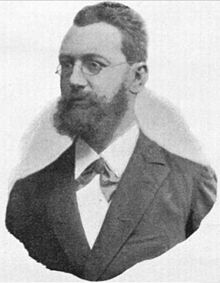Martin Kiliani
Martin Kiliani (born April 22, 1858 in Würzburg , † January 21, 1895 in Munich ) was a director of Aluminum-Industrie-Aktiengesellschaft (AIAG), later Alusuisse .
Kiliani was the son of a police commissioner and attended the humanistic grammar school in Bamberg and Regensburg . From 1875 he studied chemistry at the University of Munich and passed the teaching examination in the natural sciences. Afterwards he was assistant to Carl Stölzel at the technical university in Munich, who entrusted him with the editing of a new edition of his textbook on metallurgy. In addition, he delved into electrochemistry and its application in ore processing and metal extraction and published from 1883 to 1885 in the Berg- und Hüttenmännische Zeitung. This established his reputation and gave him the job as a chemist at the German Edison Society (later AEG ) in Berlin (1885), where he improved filament and light bulbs and began to deal with the electrolytic aluminum production. He was so successful in this that AEG wanted to start large-scale production and to do this, teamed up with the Swiss Metallurgical Society to form Aluminum-Industrie-Aktiengesellschaft in Neuhausen (1888, forerunner of Alusuisse), which used the Rhine Falls near Schaffhausen to generate electricity. Kiliani became its director. On the Swiss side, Paul Héroult's patents were incorporated (Héroult's process), which Kiliani improved with his own ideas. They developed the electric arc furnace together . This made aluminum production much cheaper.
Kiliani's inventions also played a role in the establishment of the Elektrochemische Werke Bitterfeld ( chlor-alkali electrolysis ).
His older brother Heinrich was also a chemist.
literature
- F. Regelsberger: In memory of Dr. Martin Kiliani: "Take it all in all: he was a man." In: Journal for electrical engineering and electrochemistry. 1, 1895, pp. 525-530, doi : 10.1002 / bbpc.18950011702 .
Individual evidence
- ↑ Winfried R. Pötsch, Annelore Fischer and Wolfgang Müller with the assistance of Heinz Cassebaum: Lexicon of important chemists , VEB Bibliographisches Institut Leipzig, 1988, p. 235, ISBN 3-323-00185-0 .
| personal data | |
|---|---|
| SURNAME | Kiliani, Martin |
| BRIEF DESCRIPTION | Director of Aluminum-Industrie-Aktiengesellschaft (AIAG), later Alusuisse . |
| DATE OF BIRTH | April 22, 1858 |
| PLACE OF BIRTH | Wurzburg |
| DATE OF DEATH | January 21, 1895 |
| Place of death | Munich |
